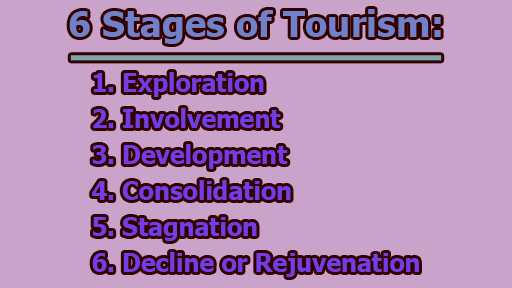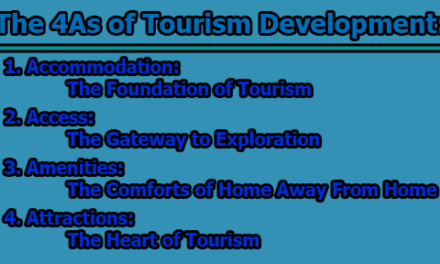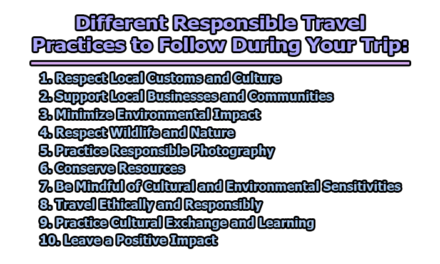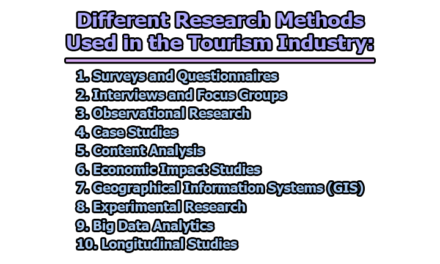6 Stages of Tourism:
Tourism is a dynamic and ever-evolving industry that can have a profound impact on both destinations and the people who visit them. The development of tourism in a particular location typically follows a series of stages, each characterized by distinct features and challenges. These stages, from exploration to decline or rejuvenation, provide a framework for understanding the life cycle of tourism in a destination. In this article, we will delve into the 6 stages of tourism, highlighting the defining characteristics and key factors associated with each stage.
1. Exploration:
The exploration stage represents the initial phase of tourism development in a destination. During this phase, the destination is relatively unknown to tourists, and there is limited infrastructure and services geared toward visitors.
1.1 Characteristics:
- Unspoiled Natural Attractions: Exploration often occurs in areas with unique and pristine natural attractions, such as untouched beaches, lush forests, or stunning landscapes. These natural wonders are the primary draw for the early adventurers.
- Cultural Appeal: Some destinations in the exploration phase also attract tourists through their cultural richness. Indigenous tribes, unique handicrafts, and traditional ceremonies can pique the interest of cultural enthusiasts.
- Low Tourist Numbers: Due to the lack of promotion and infrastructure, the number of tourists is minimal during this stage. This low volume of visitors preserves the destination’s unspoiled nature.
- Limited Accessibility: Limited transportation options and challenging access routes are common during the exploration phase, which deters all but the most intrepid travelers.
- Focus on Authenticity: In the exploration stage, tourists are often driven by a desire for authentic experiences. They are willing to accept basic accommodations and services in exchange for the novelty and untouched nature of the destination.
1.2 Key Factors: Minimal infrastructure, lack of awareness, low tourist numbers, limited access, and an emphasis on natural and cultural attractions are the key factors associated with the exploration stage. This phase is characterized by a pristine and undiscovered environment that appeals to adventurous and culturally curious travelers.
2. Involvement:
The involvement stage marks the point where tourists start to take notice of the destination, and the number of visitors begins to increase. Basic tourism infrastructure and services begin to emerge.
2.1 Characteristics:
- Early Adopters: In this phase, tourists are often early adopters who are willing to explore a destination before it becomes popular. They accept limited amenities and infrastructure in exchange for the opportunity to experience the destination in its early, unspoiled state.
- Emergence of Services: As more tourists arrive, the local economy begins to adapt. Basic accommodations, such as guesthouses and small-scale restaurants, start to cater to visitors.
- Cultural Interactions: Involvement often brings tourists into contact with the local culture. This can lead to cultural exchange and the involvement of the local community in tourism-related activities.
- Local Entrepreneurs: Some local entrepreneurs may seize the opportunity to offer services and experiences to visitors, contributing to the budding tourism economy.
- Gradual Growth: While the number of tourists is increasing, the growth is still relatively slow, maintaining the destination’s charm and authenticity.
2.2 Key Factors: The involvement stage is characterized by the emergence of basic tourist services, early adopters, cultural interactions, and the gradual involvement of the local community. Tourists during this phase are typically those seeking authentic, off-the-beaten-path experiences.
3. Development:
The development phase is marked by significant growth in tourist arrivals and the concurrent development of infrastructure, services, and marketing efforts. The economic potential of tourism becomes evident to governments, investors, and businesses.
3.1 Characteristics:
- Tourist Arrivals Surge: During the development stage, the number of tourists significantly increases, and the destination starts gaining recognition on a broader scale.
- Infrastructure Investments: Both public and private sector investments lead to the development of essential infrastructure, including airports, roads, and utilities. Hotel and restaurant chains may enter the market.
- Marketing Campaigns: The destination actively promotes itself to attract more visitors. Marketing campaigns target a wider audience, often internationally.
- Economic Impact: Tourism becomes a substantial contributor to the local economy, creating jobs, generating revenue, and increasing the overall standard of living in the area.
- Diversification of Offerings: New attractions, activities, and accommodations emerge, catering to a broader range of tourists, from budget travelers to luxury seekers.
3.2 Key Factors: Key characteristics of the development stage include significant increases in tourist numbers, infrastructure development, active marketing campaigns, and a noticeable boost to the local economy. This stage reflects the rapid expansion of the destination’s tourism sector.
4. Consolidation:
The consolidation stage is characterized by a destination that has successfully attracted tourists and developed its infrastructure. During this phase, the pace of growth may slow down, but tourism remains a significant contributor to the local economy.
4.1 Characteristics:
- Steady Growth: Tourist numbers continue to increase, but at a more stable and manageable rate compared to the previous development phase.
- Mature Infrastructure: The destination’s infrastructure is well-developed, with a wide range of accommodations, restaurants, and transportation options, often including luxury offerings.
- Quality Improvements: There’s a shift from quantity to quality, with a focus on enhancing visitor experiences and services.
- Sustainable Practices: There’s a growing awareness of the need for sustainable tourism practices to preserve the destination’s natural and cultural assets.
- Broad Range of Visitors: The destination attracts a diverse array of visitors, from budget travelers to high-end tourists, leading to a more balanced and stable economy.
4.2 Key Factors: The consolidation stage is marked by stable growth, well-developed infrastructure, quality improvements, a focus on sustainability, and a broad and diverse visitor base. This phase represents the maturation of the destination’s tourism industry.
5. Stagnation:
In the stagnation stage, the destination may start experiencing challenges associated with overdevelopment, overcrowding, environmental degradation, and a decline in the quality of the visitor experience. This can lead to negative consequences for both the destination and its residents.
5.1 Characteristics:
- Overcrowding: The destination may become overcrowded with tourists during peak seasons, leading to congestion at popular attractions and infrastructure.
- Environmental Degradation: Uncontrolled tourism growth can lead to environmental damage, such as pollution, habitat destruction, and overuse of natural resources.
- Decline in Quality: The quality of the visitor experience may deteriorate due to overcrowding, a focus on mass tourism, and commercialization.
- Local Community Concerns: As the negative impacts of tourism become more evident, the local community may start expressing concerns, such as rising living costs and cultural dilution.
- Overtourism Issues: Stagnation can be closely associated with overtourism, which threatens the sustainability and attractiveness of the destination.
5.2 Key Factors: Stagnation is characterized by overcrowding, environmental degradation, declining quality of the visitor experience, community concerns, and overtourism issues. This stage poses significant challenges that require management and mitigation efforts.
6. Decline or Rejuvenation:
The final stage represents a crossroads for the destination. It can either experience a continued decline in tourist numbers and associated issues, or it can take proactive measures to rejuvenate and revitalize its tourism sector.
6.1 Characteristics:
- Decline Scenario: In the decline scenario, tourism-related businesses may close, and the destination’s reputation may suffer. Negative impacts and a tarnished image can drive tourists away.
- Rejuvenation Scenario: In the rejuvenation scenario, the destination acknowledges its problems and takes deliberate steps to address issues related to overcrowding, environmental degradation, and declining quality.
- Sustainability Efforts: Rejuvenation often involves a commitment to sustainable practices and responsible tourism management.
- Community Engagement: Successful rejuvenation requires the active involvement of the local community in decision-making and planning for the future of tourism.
- Marketing and Repositioning: In the rejuvenation phase, the destination may launch marketing campaigns to reposition itself and attract a more responsible and sustainable traveler base.
6.2 Key Factors: In the decline or rejuvenation stage, the destination faces the choice of further decline or proactive rejuvenation. Factors include negative impacts, sustainability efforts, community engagement, and strategic marketing for revitalization.
In conclusion, the journey through the six stages of tourism development offers a comprehensive view of the evolution of a destination as it moves from obscurity to prominence and, potentially, to a crossroads of challenges and opportunities. As tourism becomes an increasingly vital part of the global economy, understanding these stages is essential for effective planning and management. Sustainability, responsible tourism practices, and community involvement play pivotal roles in ensuring that a destination can thrive and provide enriching experiences for travelers, all while preserving its unique natural and cultural heritage. Whether a destination is in the stages of exploration, consolidation, or somewhere in between, the lessons learned from this progression can guide both tourists and the tourism industry toward a more harmonious and sustainable future.

Assistant Teacher at Zinzira Pir Mohammad Pilot School and College










